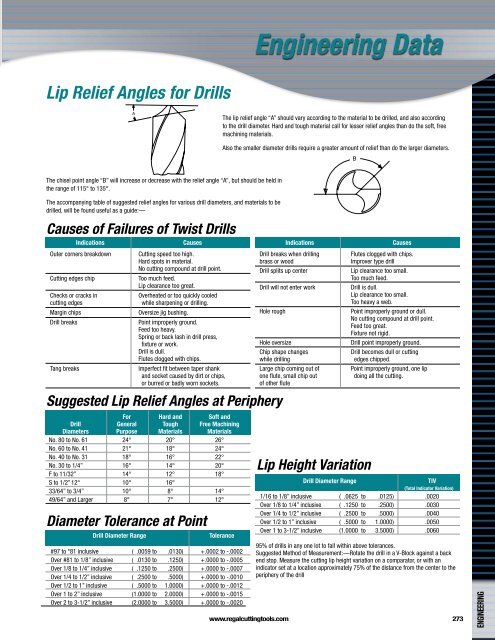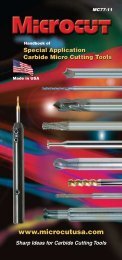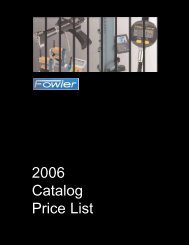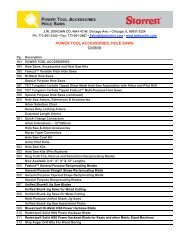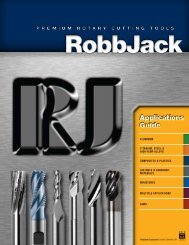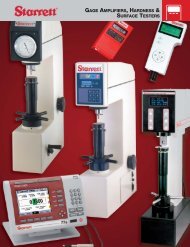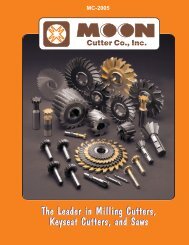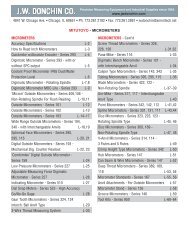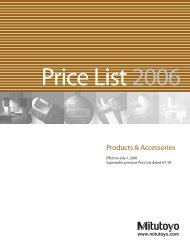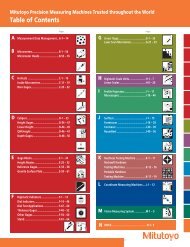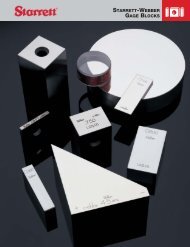Regal Cutting Tools Catalog.pdf - JW Donchin CO.
Regal Cutting Tools Catalog.pdf - JW Donchin CO.
Regal Cutting Tools Catalog.pdf - JW Donchin CO.
Create successful ePaper yourself
Turn your PDF publications into a flip-book with our unique Google optimized e-Paper software.
Lip Relief Angles for Drills<br />
A<br />
The lip relief angle “A” should vary according to the material to be drilled, and also according<br />
to the drill diameter. Hard and tough material call for lesser relief angles than do the soft, free<br />
machining materials.<br />
Also the smaller diameter drills require a greater amount of relief than do the larger diameters.<br />
B<br />
The chisel point angle “B” will increase or decrease with the relief angle “A”, but should be held in<br />
the range of 115° to 135°.<br />
The accompanying table of suggested relief angles for various drill diameters, and materials to be<br />
drilled, will be found useful as a guide:—<br />
Causes of Failures of Twist Drills<br />
Indications<br />
Outer corners breakdown<br />
<strong>Cutting</strong> edges chip<br />
Checks or cracks in<br />
cutting edges<br />
Margin chips<br />
Drill breaks<br />
Tang breaks<br />
Causes<br />
<strong>Cutting</strong> speed too high.<br />
Hard spots in material.<br />
No cutting compound at drill point.<br />
Too much feed.<br />
Lip clearance too great.<br />
Overheated or too quickly cooled<br />
while sharpening or drilling.<br />
Oversize jig bushing.<br />
Point improperly ground.<br />
Feed too heavy.<br />
Spring or back lash in drill press,<br />
fixture or work.<br />
Drill is dull.<br />
Flutes clogged with chips.<br />
Imperfect fit between taper shank<br />
and socket caused by dirt or chips,<br />
or burred or badly worn sockets.<br />
Suggested Lip Relief Angles at Periphery<br />
For Hard and Soft and<br />
Drill General Tough Free Machining<br />
Diameters Purpose Materials Materials<br />
No. 80 to No. 61 24° 20° 26°<br />
No. 60 to No. 41 21° 18° 24°<br />
No. 40 to No. 31 18° 16° 22°<br />
No. 30 to 1/4” 16° 14° 20°<br />
F to 11/32” 14° 12° 18°<br />
S to 1/2” 12° 10° 16°<br />
33/64” to 3/4” 10° 8° 14°<br />
49/64” and Larger 8° 7° 12°<br />
Diameter Tolerance at Point<br />
Drill Diameter Range<br />
Tolerance<br />
#97 to *81 inclusive ( .0059 to .0130) +.0002 to -.0002<br />
Over #81 to 1/8” inclusive ( .0130 to .1250) +.0000 to -.0005<br />
Over 1/8 to 1/4” inclusive ( .1250 to .2500) +.0000 to -.0007<br />
Over 1/4 to 1/2” inclusive ( .2500 to .5000) +.0000 to -.0010<br />
Over 1/2 to 1” inclusive ( .5000 to 1.0000) +.0000 to -.0012<br />
Over 1 to 2” inclusive (1.0000 to 2.0000) +.0000 to -.0015<br />
Over 2 to 3-1/2” inclusive (2.0000 to 3.5000) +.0000 to -.0020<br />
Indications<br />
Drill breaks when drilling<br />
brass or wood<br />
Drill splits up center<br />
Drill will not enter work<br />
Hole rough<br />
Hole oversize<br />
Chip shape changes<br />
while drilling<br />
Large chip coming out of<br />
one flute, small chip out<br />
of other flute<br />
Lip Height Variation<br />
Causes<br />
Flutes clogged with chips.<br />
Improver type drill<br />
Lip clearance too small.<br />
Too much feed.<br />
Drill is dull.<br />
Lip clearance too small.<br />
Too heavy a web.<br />
Point improperly ground or dull.<br />
No cutting compound at drill point.<br />
Feed too great.<br />
Fixture not rigid.<br />
Drill point improperly ground.<br />
Drill becomes dull or cutting<br />
edges chipped.<br />
Point improperly ground, one lip<br />
doing all the cutting.<br />
Drill Diameter Range<br />
TIV<br />
(Total Indicator Variation)<br />
1/16 to 1/8” inclusive ( .0625 to .0125) .0020<br />
Over 1/8 to 1/4” inclusive ( .1250 to .2500) .0030<br />
Over 1/4 to 1/2” inclusive ( .2500 to .5000) .0040<br />
Over 1/2 to 1” inclusive ( .5000 to 1.0000) .0050<br />
Over 1 to 3-1/2” inclusive (1.0000 to 3.5000) .0060<br />
95% of drills in any one lot to fall within above tolerances.<br />
Suggested Method of Measurement:—Rotate the drill in a V-Block against a back<br />
end stop. Measure the cutting lip height variation on a comparator, or with an<br />
indicator set at a location approximately 75% of the distance from the center to the<br />
periphery of the drill<br />
www.regalcuttingtools.com 273<br />
ENGINEERING


